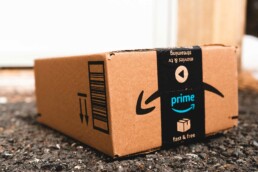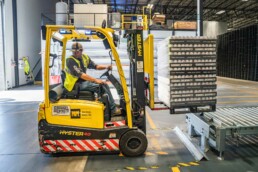Embracing the Future: Trends and Insights in DTC Fulfillment
Embracing the Future: Trends and Insights in DTC Fulfillment for 2024
Hey there, folks! Gabino Chacon here, the senior Sales Executive at Falcon Fulfilment and today we’re diving into the exciting world of Direct-to-Consumer (DTC) fulfillment in the evolving e-commerce landscape. Buckle up and get ready to explore the future trends and insights that will shape DTC fulfillment in 2024. And guess what? Falcon Fulfillment is right there on the front lines, embracing these trends to revolutionize the experience for our partners.

I. The State of DTC Fulfillment
A. Impact of the rise of DTC fulfillment services in recent years
Let’s face it, the rise of DTC fulfillment services has been a game-changer in the e-commerce world. It’s like discovering a hidden talent and realizing you’ve got something special to offer. DTC fulfillment allows businesses to cut out the middleman and connect directly with their customers, delivering a more personalized experience and increasing those profit margins. It’s about taking control and unleashing your true potential.
B. Changes in the DTC fulfillment landscape and customer expectations
But hey, with great power comes great responsibility, and customer expectations are soaring higher than ever before. In the age of instant gratification, they, and I’m they, want it all: faster delivery, seamless experiences, and transparency throughout the fulfillment process. That’s where Falcon Fulfillment steps in, ready to meet those sky-high expectations and exceed them.
II. Trend 1: DTC Fulfillment Continues to Gain Popularity
A. Adoption of hybrid warehouse models to serve B2B and DTC clients
We’re witnessing a fascinating trend, my friends. Businesses are adopting hybrid warehouse models, serving both B2B and DTC clients with flair. It’s like being a master of disguise, seamlessly juggling different roles. Falcon Fulfillment understands this game and is right there on the cutting edge, optimizing inventory management and fulfillment processes to deliver timely results for both wholesale and direct customers.
B. Increasing need for third-party logistics (3PL) providers in DTC fulfillment
In the ever-evolving world of DTC fulfillment, the need for third-party logistics (3PL) providers is on the rise. These heroes of your porch deliveries, offer specialized expertise, scalable infrastructure, and advanced technologies to navigate the intricacies of DTC fulfillment. Falcon Fulfillment is proud to be your go-to partner, helping you focus on what you do best while we handle the seamless order fulfillment and ensure those customers walk away with a smile.
III. Trend 2: Warehouse Management Systems (WMS)
A. Role of WMS in optimizing warehouse operations and reducing complexity
Warehouse Management Systems (WMS) are like magic wands, optimizing warehouse operations and reducing complexity. Falcon Fulfillment knows the importance of these tools and how they can work wonders. With our cutting-edge WMS solutions, we streamline operations, improve inventory accuracy, and make sure everything is as smooth as a well-rehearsed dance routine.
B. Benefits of cloud-based WMS for real-time visibility and streamlining processes
Ah, the cloud! It’s like floating on a fluffy cloud of possibilities. Cloud-based WMS solutions offer real-time visibility, streamlining processes, and giving you the power to make data-driven decisions. Falcon Fulfillment’s cloud-based WMS ensures that you have your finger on the pulse of your fulfillment operations 24/7, integrating seamlessly with other systems and scaling effortlessly to meet the demands of your growing business.

IV. Trend 3: Addressing Labor Shortages
A. Impact of labor shortages in the supply chain industry
Labor shortages? They’re like having half the cast missing on opening night. The supply chain industry is grappling with this challenge. Falcon Fulfillment recognizes the importance of a talented and motivated workforce. That’s why we prioritize attracting and retaining top talent, creating an environment that nurtures growth, and keeps the fulfillment show running smoothly. This is especially important to address volume spikes, maintain our culture, and keep the vision of Falcon moving in a positive direction.
B. Strategies for attracting and retaining employees in DTC fulfillment
To win the talent game, businesses must be creative and offer enticing strategies to attract and retain employees in DTC fulfillment. Falcon Fulfillment goes above and beyond, offering competitive compensation packages, comprehensive training programs, and a workplace culture that feels like family. We’re all about creating an environment where people can shine, ensuring that the fulfillment experience is a win-win for our partners and our amazing team.
V. Trend 4: Smarter Fulfillment Approaches
A. Embracing automation and algorithms to meet the demands of DTC fulfillment
Automation and algorithms? They’re like having an army of highly skilled assistants, ready to tackle the demands of DTC fulfillment. Falcon Fulfillment harnesses the power of automation and algorithms, ensuring lightning-fast order processing, accurate inventory management, and optimized fulfillment from start to finish. It’s like having a well-choreographed dance routine on stage, where every move is perfectly synchronized.
B. Importance of distributed fulfillment and adapting systems for DTC needs
In the world of DTC fulfillment, distributed fulfillment networks are like having strategically placed satellites, reaching customers with lightning speed. Falcon Fulfillment understands this importance and adapts systems to meet DTC needs. We ensure your products are stocked in the right places, minimizing shipping times, reducing costs, and maximizing customer satisfaction. It’s all about making those customers say, “Wow, that was fast!”
VI. Trend 5: Leveraging Data and Analytics in DTC Fulfillment
A. Importance of data visibility and analytics in DTC fulfillment operations
Data visibility and analytics are like having X-ray vision, allowing you to see through the complexities of DTC fulfillment operations. Falcon Fulfillment knows the power of data and how it fuels success. By capturing and analyzing data, we uncover valuable insights, optimize workflows, and make informed decisions that drive efficiency and elevate the customer experience.
B. Optimizing workflows, inventory management, and customer experience with data-driven insights
Data-driven insights are like having the ultimate playbook, optimizing workflows, inventory management, and the customer experience in DTC fulfillment. Falcon Fulfillment’s analytics-driven approach helps us identify opportunities for improvement, prevent stockouts, and deliver a seamless end-to-end fulfillment experience. It’s all about those satisfied customers who keep coming back for an encore.
Beginner’s Guide to Third-Party Logistics (3PL)
The world of e-commerce is always changing, therefore understanding the roll of Third-Party Logistics is integral to keeping up. In light of this our beginner’s guide to third-party logistics (3PL) will delve into the essential aspects, offering insights into fulfillment services, warehousing, and much more.
Read More…
The future of DTC fulfillment in 2024 is brimming with exciting trends and insights. Here at Falcon Fulfillment we take these trends to heart, embracing technology, automation, and data-driven strategies to ensure our partners thrive in the DTC landscape. From adopting hybrid warehouse models to leveraging advanced WMS solutions, addressing labor shortages, and optimizing fulfillment approaches, Falcon Fulfillment is here to make your fulfillment experience shine like a blockbuster hit.
So let’s step into the spotlight together, analyze your current process, and continue to make 2024 a year of fulfillment success!
Protecting Against Porch Pirates
Protecting Against Porch Pirates: Falcon Fulfillment and the Power of UPS Capital Insurance
Hello from Falcon Fulfillment! As a trusted 3PL (Third-Party Logistics) provider, we understand the challenges faced by both sellers and buyers during delivery. Protecting against porch pirates is one of the most concerning issues in recent years, and it’s on the rise. At Falcon Fulfillment, we prioritize the safety and satisfaction of our customers; therefore, we are addressing this topic head-on. We will delve into the menace of porch pirates, how they operate, and how we can provide a defense against this threat.

The Porch Pirate Predicament
Porch piracy, a growing concern in the e-commerce landscape, has given rise to challenges in ensuring the secure delivery of packages. Furthermore, as packages pile up on doorsteps across the nation, opportunistic thieves take advantage of this abundance, preying on unguarded parcels. At Falcon Fulfillment, we recognize that this issue affects not just the recipients who lose their goods but also the sellers who wish to protect their customers’ valuable purchases.
Porch Pirates’ Tactics
Porch pirates are evolving their approach, employing various tactics to target vulnerable shipments:
1. Opportunistic Scouting: These thieves may monitor neighborhoods, identifying patterns of package deliveries to strike when homeowners are away or less likely to be vigilant.
2. Tracking Delivery Trucks: Some porch pirates shadow delivery trucks, meanwhile waiting for the perfect moment to swoop in and snatch unattended packages.
3. Deceptive Impersonation: In some cases, these criminals go the extra mile, impersonating delivery drivers or representatives to deceive trusting neighbors into handing over their packages unknowingly.

The Falcon Fulfillment and UPS Capital Insurance Solution
As a dedicated 3PL partner, Falcon Fulfillment takes package security seriously. Moreover, to counter the porch pirate menace, we have joined forces with UPS Capital Insurance to offer a robust defense for your shipments.
1. Comprehensive Coverage: UPS Capital Insurance extends comprehensive coverage that safeguards your shipments from the moment they leave the warehouse until they safely reach their intended destination. Importantly, this includes robust protection against the unfortunate event of porch piracy.
2. Piece of Mind: Furthermore, by having UPS Capital Insurance as a part of our logistics solution, you can rest easy, assured that your customers’ orders are protected throughout the entire delivery process. Additionally, UPS Capital Insurance allows you to safeguard your business, thus providing peace of mind that shipments are secured. Ultimately, with UPS Capital coverage, you can relax knowing that goods are shielded from loss or damage. Consequently, this peace of mind allows you to focus on growing your business and delighting your clientele.
3. Secure Delivery Protocols: At Falcon Fulfillment and with UPS Capital Insurance, we prioritize secure delivery options. Specifically, by requiring signatures for deliveries, we ensure that packages end up in the right hands.
4. Trust and Reliability: By emphasizing the use of UPS Capital Insurance in your shipping process, it underscores your commitment to customer satisfaction and reinforces trust in your brand. Consequently, this trust translates into loyal customers who consistently return for repeat business.
Beginner’s Guide to Third-Party Logistics (3PL)
The world of e-commerce is always changing, therefore understanding the roll of Third-Party Logistics is integral to keeping up. In light of this our beginner’s guide to third-party logistics (3PL) will delve into the essential aspects, offering insights into fulfillment services, warehousing, and much more.
Read More…
With Falcon Fulfillment and UPS Capital Insurance by your side, you can confidently ship your products, knowing they are in safe hands. Our shared commitment to security and customer satisfaction ensures that your packages reach their intended recipients, free from the clutches of porch pirates. Experience the peace of mind that comes from a partnership built on trust and reliability. Choose Falcon Fulfillment for your logistics needs, and let’s create a safer and more secure future for your customers together.
If you’re ready to start defending your deliveries, contact us to learn more about our services.
Let’s Talk!
Black Friday 2024 Predictions: Strategies, Challenges, and Social Media Importance
Black Friday 2024 Predictions: Strategies, Challenges, and Social Media Importance
The countdown to Black Friday 2024 has begun, and with it comes a fresh set of challenges, opportunities, and strategies for retailers and e-commerce businesses. This year, a sharper focus on supply chain management, fulfillment services, and the influence of social media marketing will be critical for maximizing revenue. Here’s what to expect and how to prepare.

Analyzing Trends from Previous Black Fridays
Looking back at Black Friday 2023, we saw record-breaking sales despite economic uncertainties. The growing adoption of e-commerce fulfillment and an increased reliance on third-party logistics (3PL) services enabled businesses to handle large order volumes seamlessly.
Retailers also leaned on social media platforms like TikTok and Instagram to reach younger, deal-savvy audiences. These platforms aren’t just trend setters—they’re deal finders. Expect this trend to deepen in 2024 as more consumers rely on social media for discovering sales and promotions.
Strategies for Black Friday 2024
Embrace Inventory Optimization
Efficient inventory management is essential for handling high-demand periods like Black Friday. Utilizing cloud-based warehouse management systems (WMS) ensures real-time updates on stock levels, helping businesses prevent overselling or running out of inventory.
Improve Shipping and Delivery Options
The demand for same-day and next-day delivery is higher than ever. Businesses should streamline their logistics using tools like a transportation management system (TMS) and focus on last-mile delivery strategies to satisfy customers’ growing expectations for speed and reliability.
Capitalize on Social Media’s Growing Role
Social media has evolved into a powerful tool for creating urgency and excitement around Black Friday deals. Live shopping events, interactive posts, and influencer partnerships can help retailers increase visibility and drive engagement.
Leverage Value-Added Services (VAS)
Offering services like kitting and assembly, bulk shipping, or even customizable packaging can make your brand stand out. These extras often translate into better customer loyalty and satisfaction.
Addressing Challenges for 2024
While the opportunities are plentiful, Black Friday 2024 comes with its own set of challenges.
Supply Chain Disruptions
Ongoing global events continue to affect freight forwarding, customs brokerage, and international shipping. Businesses must prioritize supply chain optimization and vendor-managed inventory (VMI) systems to mitigate these risks.
Rising Costs in Warehousing and Distribution
As operational costs rise, optimizing warehousing and distribution is key. Consider incorporating warehouse automation to improve efficiency and reduce labor costs.
Ensuring Order Accuracy
Maintaining order accuracy and quality control is critical during the rush of Black Friday. Missteps here can lead to costly returns, negatively impacting both profits and reputation.
The Role of Social Media in Black Friday 2024
Social media isn’t just an optional channel; it’s a necessity. Why? Because it offers a direct line to consumers. Platforms like Facebook, Instagram, and X (formerly Twitter) allow brands to target shoppers with precision.
- Interactive Promotions: Host giveaways or flash sales exclusively on social media.
- User-Generated Content (UGC): Encourage customers to share their purchases and tag your brand for a chance to win prizes.
- Video Content: Short-form video content can highlight the best deals and generate excitement.
Using order tracking and management systems to integrate live updates into social platforms can further enhance the customer experience by keeping them informed about their purchases.
Emerging E-Commerce Trends for Black Friday 2024
Multi-Channel Fulfillment
ntegrating physical and online stores allows businesses to offer options like in-store pickup or hybrid shopping models, boosting convenience.
Sustainability
As consumers become more eco-conscious, offering sustainable shipping and packaging optimization solutions will resonate with shoppers.
Reverse Logistics for Returns
With higher sales, there’s a greater likelihood of returns. Efficient reverse logistics systems can turn this challenge into a competitive advantage by providing hassle-free return experiences.
Emerging E-Commerce Trends for Black Friday 2024
Multi-Channel Fulfillment
ntegrating physical and online stores allows businesses to offer options like in-store pickup or hybrid shopping models, boosting convenience.
Sustainability
As consumers become more eco-conscious, offering sustainable shipping and packaging optimization solutions will resonate with shoppers.
Reverse Logistics for Returns
With higher sales, there’s a greater likelihood of returns. Efficient reverse logistics systems can turn this challenge into a competitive advantage by providing hassle-free return experiences.
Why Fulfillment Services Are Essential
Managing the complexities of Black Friday requires robust order fulfillment solutions. Partnering with experienced 3PL technology solutions providers can streamline operations, improve order accuracy, and reduce shipping delays.
A well-integrated inventory tracking software ensures that stock levels are updated across all channels, enabling businesses to promise accurate delivery dates.
Preparing for Black Friday 2024
With Black Friday 2024 predictions indicating heightened competition, early preparation is the key to success. Focus on these three areas:
Demand Planning and Forecasting
Use historical sales data and predictive analytics to anticipate consumer demand accurately.
Scalable Fulfillment Solutions
Ensure your fulfillment center has the flexibility to handle a surge in orders during the Black Friday weekend.
Enhanced Customer Experience
Offering perks like free returns, on-time delivery, and live order tracking can help differentiate your brand in a crowded market.
Beginner’s Guide to Third-Party Logistics (3PL)
The world of e-commerce is always changing, understanding the roll of Third-Party Logistics is integral to keeping up. This beginner’s guide to third-party logistics (3PL) will delve into the essential aspects, offering insights into fulfillment services, warehousing, and much more.
Read More…
Preparations for Black Friday 2024
Black Friday 2024 will test businesses’ agility, creativity, and operational efficiency. Success will hinge on adopting advanced e-commerce fulfillment strategies, optimizing shipping and delivery, and leveraging social media to its fullest potential.
By addressing challenges like supply chain disruptions and focusing on scalable solutions, businesses can maximize revenue during this high-stakes shopping event. Start planning now, and make Black Friday 2024 your most profitable one yet.
Let’s Talk!
Order Fulfillment Pricing: Why Details Matter
Order Fulfillment Pricing: Why Details Matter
In today’s fiercely competitive e-commerce landscape, understanding the intricate details of order fulfillment pricing is paramount for e-retailers. Quick quotes may seem enticing but often result in unforeseen expenses. Falcon Fulfillment, dedicated to offering top-tier fulfillment services, is here to guide you through the process.

Order Fulfillment Pricing Basics
Understanding order fulfillment pricing requires a deep dive into its key cost components:
1. Setup Charges: These one-time fees are essential for seamless integration between your systems and the fulfillment provider’s systems, ensuring uninterrupted operations.
2. Receiving Charges: Costs associated with the intake of your products, including tasks like counting, inspection, and labeling. It’s the initial step in the fulfillment process and sets the stage for smooth operations.
3. Storage Charges: Monthly fees for housing your goods within the fulfillment center. These charges are influenced by various factors, including the duration of storage, size of items, and any special storage requirements. For instance, temperature-controlled storage may come at a premium. Furthermore, storage charges can vary greatly based on the location of the fulfillment center. Storing products in or near major metropolitan areas often comes at a higher cost, but it can lead to lower shipping costs due to proximity to customers.
4. Pick and Pack Fees: These costs are exactly as the name implies – they cover the labor and resources needed to pick and pack your products, making them ready for shipment. This stage typically incurs the most significant labor costs. However, the exact costs can vary based on the complexity of your processes. Do you have unique packout requirements? Are there a high volume of returns that need processing? These variables can significantly impact your pick and pack expenses.
Beware the Instant Quote for Fulfillment Services
Quick quotes for fulfillment services might seem convenient, but they often fall short in terms of accuracy. While they can provide you with a rough estimate, they rarely encompass all the details required for precise pricing.
The allure of a quick quote is akin to fast food. It’s a convenient option that saves you time in the short run. However, is it truly the best solution for your long-term needs? The short answer is no.
Fulfillment pricing based on high-level data may require re-pricing once the provider starts operating and realizes that many of the assumptions made for the initial price quote were inaccurate. Unfortunately, most re-pricing exercises don’t result in a price decrease.
Imagine being four months into an outsourcing partnership and having to explain to your superiors why the order fulfillment budget needs a significant increase. It’s not an ideal scenario and can harm your reputation.
This is why it’s crucial to be cautious of fulfillment service providers that don’t push for as much detail as possible. While they might seem easy to work with in the short term, the path to cost-efficiency and successful e-commerce operations begins with a meticulous evaluation that delves beyond the surface-level appeal of instant quotes.
To ensure accurate cost estimates and avoid unforeseen expenses, it’s imperative to delve into the specifics of order fulfillment pricing. In the next section, we explore the critical details that can significantly influence your order fulfillment pricing, emphasizing that more detail is not only the key to accuracy but also to cost savings.

Details You Can Provide a 3PL for Accurate Pricing
As the saying goes, “pay now or pay later.” It’s best to do your homework before seeking e-commerce fulfillment services. Here are some of the details that the best and most trustworthy fulfillment partners will want from you:
1. A Full Description of Your Products:
One of the fundamental pieces of information required for optimal 3PL order fulfillment pricing is a comprehensive description of your products. This includes details such as the total quantity, dimensions, and SKUs per case. Understanding your products enables your 3PL to determine storage and picking space requirements. It helps them decide whether your inventory can be stored vertically or horizontally, the strength of racking needed, and the size of the pick front required.
2. Fragile or Hazardous Products:
If any of your SKUs are fragile or hazardous, it’s vital to communicate this information to your partner. These products often require special storage and handling, which can significantly impact 3PL order fulfillment services pricing.
3. Palletized vs. Floor-Loaded Shipments:
Providing insights into the ratio of palletized vs. floor-loaded shipments is crucial. It helps your 3PL forecast the labor, time, and space required to receive shipments accurately, reducing the risk of bottlenecks during the receiving phase.
4. SKU Makeup of Inbound Shipments:
Your 3PL needs to know the average number of SKUs per shipment and the number of pallets or cases created from each inbound shipment. They also need to understand the percentage of cartons or pallets that contain mixed SKUs vs. a single SKU. Detailed data in these areas helps prevent unexpected dock delays and charges.
5. Special Receiving Requirements:
If your inbound receiving process requires more than a basic general inspection, this should be communicated. Tasks like barcoding, labeling, or quality audits can impact dock-to-stock time and costs.
6. Special Storage, Stock Rotation, or Handling:
Products that require special storage conditions, stock rotation, or specific handling instructions must be highlighted. Whether it’s temperature-controlled space or specific shipping requirements like FIFO (First-In, First-Out) or FEFO (First-Expired, First-Out), these details can significantly impact storage and operational costs.
7. Average Weight of Pallets or Cartons:
Knowing the average weight of your standard pallets or cartons is essential. It helps determine whether your pallets can be stacked and how many can be stacked, allowing your 3PL to find the most effective configuration and racking choice to control your storage charges.
8. Number of Unique SKUs in Storage:
The count of unique SKUs in storage directly affects fulfillment center pricing. Each SKU requires its own slot or bin in the fulfillment center, so the more SKUs you have, the more space and expense are needed. Providing precise data in this regard ensures accurate 3PL order fulfillment pricing.
9. B2C vs. B2B Order Ratio:
Clearly defining the ratio of B2C (Business-to-Consumer) vs. B2B (Business-to-Business) orders is critical for calculating a realistic cost per order. Sharing details from your existing service level agreements helps your 3PL understand your multi-channel fulfillment operation.
10. Special or Value-Added Services:
If your orders require special or value-added services like kitting, on-the-fly kit assembly, or custom labeling, it’s vital to inform your 3PL. These services impact the scope of work and need to be accurately defined for pricing purposes.
11. Special Release Days or Promotional Spikes:
Any information related to your sales trends, special release days, or promotional spikes should be shared. This data helps your 3PL design the most efficient labor plan.
12. Packout Process for Orders:
The packout stage is where most fulfillment expenses occur. Providing detailed information about your packout process is crucial for accurate pick and pack pricing.
13. Packaging and Dunnage Materials:
Details about the types of packaging and dunnage materials you use can have a significant impact on both warehouse operations and shipping costs.
14. Returns Processing Standards:
If your company has specific standards for processing returns, these must be communicated. Returns are typically more work-intensive than order fulfillment and need accurate estimates of space and staffing.
15. Monthly Velocity of Each SKU:
Understanding the velocity of each SKU is crucial for designing an efficient storage configuration and pick line, which can have huge cost implications.
16. Order Flow Integration with 3PL’s Systems:
Seamless order flow is essential for a successful partnership with your 3PL. Details about how orders will be placed and the systems integration and data flow requirements between your systems and your 3PL’s systems must be discussed.
It’s imperative to understand that accurate and lower order fulfillment pricing hinges on the details you provide to your 3PL. The more comprehensive the information, the more precise the 3PL order fulfillment pricing, and the greater the potential for cost savings.
Order Fulfillment Pricing and Tax Accounting: More Alike Than You Think
The parallels between order fulfillment pricing and tax accounting are striking. Just as you wouldn’t entrust your taxes to an accountant who promises to complete them in an hour without gathering all the necessary information, quick quotes for fulfillment services often lead to inaccurate pricing.
The best fulfillment operators are the ones who ask plenty of questions. Our advice: indulge their appetite for details. They can use those details to create the most cost-efficient operation possible and provide a fulfillment price quote that you can confidently use for budget projections without the fear of undergoing a re-pricing exercise after the start-up.
Beginner’s Guide to Third-Party Logistics (3PL)
The world of e-commerce is always changing, understanding the roll of Third-Party Logistics is integral to keeping up. This beginner’s guide to third-party logistics (3PL) will delve into the essential aspects, offering insights into fulfillment services, warehousing, and much more.
Read More…
For expert guidance on fulfillment pricing and optimizing your order fulfillment process, reach out to Falcon Fulfillment, your dedicated partner in streamlining e-commerce operations.
Remember, controlling order fulfillment costs is pivotal in staying competitive in e-commerce. Falcon Fulfillment has the experience, technology, and expertise to guide your business toward success.
Let’s Talk!
Dropshipping - Drawbacks and Alternatives
Dropshipping – Drawbacks and Alternatives
If you’re considering starting or expanding your current business, you’ve likely heard about the dropshipping business model. Dropshipping is an attractive option for companies that don’t have the capital to invest in inventory or the resources to manage the logistics of shipping products. But is it the right model for your company? In this article, we will share the benefits, drawbacks, and alternatives to dropshipping.
Dropshipping is a business model in which a company sells products without stocking them. Instead, the company purchases the items from a third-party supplier, who then ships the items directly to the customer. This model allows companies to offer a wide variety of products without the overhead of stocking inventory. The advantages of dropshipping are numerous.
If you’re getting into the dropshipping model, research different dropshippers. Many overpromise and underdeliver. To run a good business, your customers need to be happy, so you need a good dropshipper.
Jeff Moriarty, Owner of Dog Christmas Stockings
Benefits of dropshipping

Even though dropshipping isn’t for everyone, there are some distinct benefits which include:
- Less upfront capital is required to get started: To launch a successful dropshipping business, you don’t need to invest in purchasing or storing large quantities of inventory. This significantly reduces the resources required to launch your business.
- Managing orders, stock levels, inventory, and shipping are all handled by the manufacturer or vendor:
- A home-based or remote business possibility is readily available: Geography is less important when running a dropshipping business because you are not bound to a brick-and-mortar store.
- Easier to test products: You can test out various products quickly and easily, allowing you to find the best-selling items fast. All this happens without investing a lot of resources in inventory.
Drawbacks to Dropshipping

Considering dropshipping drawbacks and alternatives; even though dropshipping is great for start-ups and smaller e-commerce brands, it can become a limiting issue. There are some significant drawbacks to the dropshipping model.
Lower Profit Margins
One of the most significant drawbacks to dropshipping is lower margins. Lower upfront investment costs mean lower returns. To make a profit, you need to sell a lot more products. Most of the margin goes to the supplier managing production and fulfillment. To overcome the lower margins, it is vital to differentiate your brand in the marketplace and negotiate profitable margins with your suppliers.
Higher Shipping Costs
Shipping costs can be high since you have products shipped from multiple suppliers. A customer can theoretically order from multiple vendors if you work with numerous manufacturers (as most dropshippers do). This means that if they ordered three items from your shop, they could incur three separate shipping fees on that single order. This is one reason why shipping charges tend to be higher with dropshipping. Another reason shipping costs are higher for dropshipping is the loss of volume discounts with fulfillment carriers. Unless you are dropshipping thousands of orders with a single vendor, it isn’t likely you will benefit from economies of scale.
Lack of Quality Control
You may also have issues with quality control since you’re dealing with multiple suppliers. And the lack of control over the customer experience can be a problem if something goes wrong. You are virtually uninvolved, from managing the supply chain to selecting last-mile delivery providers. There is a much higher chance of being held responsible for a poor customer experience that you have no power to change. Your company reputation is on the line, especially when working with average or low-quality suppliers. Often customers experience missing items, botched shipments, and product quality issues. Working with reputable dropshipping manufacturers can help, but this model falls short in managing the dirty details.
Inventory Issues
Because you don’t own your inventory supply, it can become problematic. For example, when a product becomes unavailable, you may not know immediately. This could mean you sell a product that is out of stock and will need to notify a customer of the disappointing news. Vendors and suppliers are improving their real-time inventory systems with dropshippers, but it is definitely a drawback of the model.
Whether the dropshipping model is best for your company depends on your goals and resources. If you’re looking for a low-cost way to get started and are comfortable with outsourcing some of the customer experience, then dropshipping can be a great option. But if you’re looking for more control over the customer experience and don’t mind investing in inventory, you may want to consider a different business model. Here are some of the best alternatives to dropshipping for order fulfillment.
Best Alternatives for Dropshippers

Fulfillment by Amazon (FBA)
FBA is an excellent alternative to dropshipping, as it allows you to store your products in Amazon’s fulfillment centers. This means that Amazon handles the packing and shipping of your orders while you manage the product selection and pricing. FBA is a great option for businesses that sell on Amazon, as it’s simple and cost-effective.
Self-Fulfillment
Self-fulfillment is an excellent option for businesses that don’t want to outsource their order fulfillment. You manage the entire process with self-fulfillment, from receiving orders to packing and shipping them out. This can be a great way to save on costs, as you’re not paying anyone else to do the work. However, it does require more time and effort on your part. This alternative works best for businesses that have access to low-cost storage facilities and are shipping smaller quantities of products.
Third-Party Logistics (3PL)
With all the dropshipping drawbacks one great alternative is outsourced fulfillment. 3PL is a great option for businesses that want to outsource their order fulfillment but don’t want to use dropshipping. With 3PL, you partner with a third-party logistics provider who handles the entire process, from receiving orders to packing and shipping them out. This can be a great way to save money, as you’re not paying for the overhead associated with running your own fulfillment center. Furthermore, an excellent 3PL partner can provide additional services like custom branded packaging, kitting, and light assembly, as well as managing returns. If you have outgrown dropshipping and don’t want to make a significant resource investment in warehousing and staffing for fulfillment, 3PLs are a great choice.
These are just a few of the best alternatives to dropshipping for order fulfillment. Each has its advantages and disadvantages, so it’s essential to evaluate your options and choose the one that’s right for your business. You can ensure that your customers get their orders quickly and efficiently with the right fulfillment solution.
Beginner’s Guide to Third-Party Logistics (3PL)
The world of e-commerce is always changing, therefore understanding the roll of Third-Party Logistics is integral to keeping up. In light of this our beginner’s guide to third-party logistics (3PL) will delve into the essential aspects, offering insights into fulfillment services, warehousing, and much more.
Read More…
Dropshipping has its share of benefits and drawbacks. Fortunately, there are many great alternatives that can help brands fulfill orders without stifling profitability. Falcon fulfillment is a 3PL that takes pride in superior communication, onboarding, and customer success.
If you would like to learn how we can help your company scale past dropshipping, get in touch with one of our agents today.
Let’s Talk!
E-commerce Sustainability Best Practices
E-commerce Sustainability Best Practices
With the growing concern for our planet’s well-being, it’s crucial for online businesses to adopt e-commerce sustainability best practices that not only drive profits but also contribute to a greener future. In this blog post, we’ll delve into the best sustainability practices for 2023 and beyond, helping you thrive while being environmentally responsible.

Mindful Product Sourcing
Choosing sustainable suppliers and materials is the cornerstone of an eco-friendly e-commerce strategy. Accordingly, prioritize working with suppliers who follow ethical labor practices and use eco-conscious materials. ALSO Highlight your commitment to sustainability in product descriptions to resonate with environmentally conscious consumers.

Eco-Friendly Packaging
Revamp your packaging methods to minimize waste and carbon footprint. In general, opt for biodegradable, recyclable, or reusable packaging options. Not only does this reduce environmental impact, but it also enhances your brand’s image as a responsible player in the e-commerce sphere.
In addition, work with a fulfillment company that embraces a sustainable ideology; at Falcon we strive to minimize our footprint and help our customers minimize theirs. Presently to achieve this we have reduced our plastic usage by 80%. We are here to help and know the avenues to take as you source your fulfillment responsibly.

Energy-Efficient Operations
Streamline your operations by investing in energy-efficient technologies. From lighting to server infrastructure, every step toward energy conservation counts. Moreover, consider incorporating renewable energy sources like solar panels to power your warehouses and offices.

Transparent Practices for E-commerce Sustainability Best Practices
Earn the trust of your customers by being clear about your sustainability journey. Share your efforts, achievements, and future goals through engaging content on your website and social media platforms. By doing so, you demonstrate that consumers appreciate open communication and are more likely to support businesses that align with their values.
Craft marketing campaigns that highlight your commitment to sustainability. Leverage your SEO and optimize content to drive organic traffic. Additionally, showcase success stories, behind-the-scenes sustainability efforts, and collaborations with eco-friendly organizations.

Embrace the Circular Economy
Encourage customers to return used products for recycling and reuse. To facilitate this, implement a take-back program or offer incentives for returning items. By doing so, you can close the loop on product lifecycles, thereby contributing to a circular economy that ultimately minimizes waste and saves resources.

Collaborate for Impact
Join forces with other e-commerce businesses, NGOs, and sustainability-focused organizations. By doing so, collaborative initiatives can amplify your reach and influence, thereby fostering a community dedicated to driving positive change in the e-commerce industry.
Beginner’s Guide to Third-Party Logistics (3PL)
The world of e-commerce is always changing, therefore understanding the roll of Third-Party Logistics is integral to keeping up. In light of this our beginner’s guide to third-party logistics (3PL) will delve into the essential aspects, offering insights into fulfillment services, warehousing, and much more.
Read More…
This year presents a pivotal moment for e-commerce businesses to prioritize sustainability. By adopting these e-commerce sustainability best practices, you can not only reduce your environmental footprint but also attract a growing segment of eco-conscious consumers. Therefore remember, embracing sustainability isn’t just a trend – it’s a transformative journey toward a greener, more prosperous future for your e-commerce venture.
Want to see how Falcon Fulfillment can up your sustainability game?
Let’s Talk!
Controlling Order Fulfillment Costs
Controlling Order Fulfillment Costs: Effective Strategies to Optimize Your Budget
In the e-commerce landscape, controlling order fulfillment costs in the fulfillment process is crucial for any business’s success. As 3PL experts, we understand the challenges that companies face in managing their supply chains, and we’re here to shed light on the most common costs associated with order fulfillment. We will also showcase how Falcon Fulfillment can help you overcome these challenges and save your business money.

1. Order Fulfillment Costs Controlled with Inventory Management
Effective inventory management is essential for reducing fulfillment costs. Holding excess inventory ties up capital and leads to storage expenses. On the other hand, stockouts can result in lost sales and rush shipping costs. Falcon Fulfillment employs state-of-the-art inventory tracking software to maintain optimal stock levels, ensuring your products are available when your customers want them.
2. Shipping and Delivery
Shipping and delivery costs are a significant component of order fulfillment expenses. With Falcon Fulfillment’s expertise in supply chain management, you can benefit from our negotiation and consolidation strategies, reducing shipping expenses and improving efficiency. We also offer same-day and next-day delivery options, enhancing customer satisfaction.
3. Returns and Reverse Logistics
Dealing with returns can be costly and time-consuming. Falcon Fulfillment streamlines the return merchandise authorization (RMA) process, making it more efficient and cost-effective. Our scalable fulfillment solutions ensure that your returns are managed with precision.
4. Warehouse and Storage Costs
Storage expenses can quickly add up. Falcon Fulfillment operates cutting-edge fulfillment centers with warehouse automation to optimize space utilization. This results in cost savings that we pass on to our clients.

5. Packaging Optimization
Inefficient packaging can lead to increased shipping costs due to wasted space and added weight. Falcon Fulfillment specializes in packaging optimization, ensuring your products are packed securely while minimizing excess space and materials.
6. Scalable Fulfillment Solutions
Falcon Fulfillment offers scalable solutions to match your business’s growth. Whether you’re a small start-up or an established e-commerce giant, our services can adapt to your needs, ensuring you only pay for what you use.
7. E-commerce Integration Services
Integration with various e-commerce platforms is vital for a seamless order fulfillment process. Falcon Fulfillment provides multi-channel fulfillment and cloud-based warehouse management systems (WMS), ensuring your systems work together harmoniously.
Controlling order fulfillment costs with Falcon Fulfillment
Falcon Fulfillment is your partner in cost-effective order fulfillment. By implementing our order fulfillment solutions, you can reduce expenses related to warehousing, shipping, and returns, and more. As you seek to optimize your supply chain, consider Falcon Fulfillment as your trusted 3PL partner. We understand the nuances of e-commerce fulfillment and offer a wide range of services to help you succeed.
Beginner’s Guide to Third-Party Logistics (3PL)
The world of e-commerce is always changing, understanding the roll of Third-Party Logistics is integral to keeping up. This beginner’s guide to third-party logistics (3PL) will delve into the essential aspects, offering insights into fulfillment services, warehousing, and much more.
Read More…
By collaborating with us, you’ll not only control costs but also improve the overall efficiency of your supply chain, leading to better customer experiences and higher profitability. If you’re ready to take your fulfillment operations to the next level and save on costs, contact Falcon Fulfillment today.
Remember, controlling order fulfillment costs is pivotal in staying competitive in e-commerce. Falcon Fulfillment has the experience, technology, and expertise to guide your business toward success.
Let’s Talk!
Warehouse Management System Benefits: Optimizing Backorders
Optimizing Backorder Fulfillment: Warehouse Management System Benefits
A warehouse management system benefits your business by giving you the tools to manage your backorder issues. E-commerce backorders can either be a sign of high demand or a supply chain challenge. No matter the cause, ensuring efficient backorder fulfillment is critical. This article explores the benefits of implementing a Warehouse Management System (WMS) and how partnering with a 3PL provider can elevate your operations.

Understanding Backorders
Backorders occur when the demand for a product surpasses the available stock. This situation can be a sign of your product’s popularity, but it can also result from various factors, such as shipping delays or forecasting errors. Effectively managing backorders is vital to maintain customer satisfaction and prevent the negative impacts of supply chain disruptions.
The Role of 3PL Inventory Management
Third-Party Logistics (3PL) providers play a significant role in managing inventory for businesses. They offer services like warehousing, transportation, and timely delivery. These providers often employ advanced Warehouse Management System software to maintain accurate inventory data, streamline operations, and reduce costs. By outsourcing logistics to a 3PL, you can focus more on your core business activities.
Key Benefits of Warehouse Management Systems for Backorder Fulfillment
Real-Time Inventory Visibility: WMS provides up-to-the-minute inventory data, ensuring backordered items are closely monitored and allocated for fulfillment as soon as they become available.
Smart Prioritization: WMS automates the prioritization of backorders based on predefined rules, such as customer priority or shipping deadlines, reducing delays and errors.
Order Consolidation: Automation-driven systems facilitate efficient grouping of backorders, optimizing the picking and packing process.
Automated Picking and Packing: Integration with automation technologies streamlines the retrieval and packing of backordered items, improving speed and accuracy.
Dynamic Slotting: WMS uses historical data to optimize the placement of backordered items for easy accessibility, reducing picking time.
Improved Labor Management: Real-time visibility of worker performance helps balance workloads and adapt to demand fluctuations.
Handling Exceptions: WMS proactively identifies and addresses exceptions like delayed shipments or inventory discrepancies.
Easy Integration: Integration capabilities allow seamless communication with external systems, eliminating manual efforts.
What is a WMS?
A Warehouse Management System (WMS) is the unsung hero behind efficient and streamlined warehouse operations in the world of logistics and supply chain management. At its core, a WMS is a software application designed to support and optimize various functions within a warehouse or distribution center. Its primary functions can be summed up in five key areas:
Inventory Management
WMS offers real-time visibility into inventory levels. It tracks the location of every item in the warehouse, ensuring that you can locate products quickly and easily. This functionality minimizes the risk of stockouts, overstock situations, and lost items.
Order Processing
WMS plays a pivotal role in order fulfillment. It automates the picking and packing process, reducing errors, and increasing the speed and accuracy of order processing. This translates to quicker and more precise deliveries to customers.
Optimal Space Utilization
A WMS helps in the strategic allocation of products within the warehouse. It maximizes space utilization by considering factors such as item dimensions, turnover rates, and seasonal fluctuations. This results in a well-organized and efficient warehouse layout.
Task Assignment
WMS assigns tasks to warehouse personnel. It can prioritize tasks based on factors like order deadlines or customer requirements. This ensures that workers focus on the most critical activities first, improving overall productivity.
Data Analysis and Reporting
WMS is equipped to collect a wealth of data on warehouse operations. It transforms this data into meaningful insights through reporting and analytics. Warehouse managers can use these insights to make informed decisions, identify bottlenecks, and continuously optimize processes.
In essence, a WMS isn’t just a software system; it’s a strategic tool that empowers warehouses to operate at peak efficiency, reduce costs, and deliver superior customer service. Whether it’s managing inventory, processing orders, optimizing storage space, assigning tasks, or providing valuable data-driven insights, a well-implemented WMS is the backbone of a successful modern warehouse.
Future-Proofing with WMS and 3PL
In the ever-evolving e-commerce landscape, it’s not just about meeting current demands but also future-proofing your operations. By embracing a WMS and collaborating with a 3PL partner, you position your business for scalability and agility. As demand grows, you can seamlessly adapt and expand without compromising service quality.
The Expanding Role of Technology
Technology is reshaping the logistics industry. Innovations like Artificial Intelligence (AI) and the Internet of Things (IoT) are enhancing the capabilities of Warehouse Management Systems. AI can predict demand patterns, optimizing your stock levels, while IoT provides real-time data on your inventory, improving accuracy and reducing errors. Stay updated with these technologies to stay ahead in the e-commerce race.
Beginner’s Guide to Third-Party Logistics (3PL)
The world of e-commerce is always changing, understanding the roll of Third-Party Logistics is integral to keeping up. This beginner’s guide to third-party logistics (3PL) will delve into the essential aspects, offering insights into fulfillment services, warehousing, and much more.
Read More…
The implementation of a Warehouse Management System is a game-changer for efficient backorder fulfillment. Working with the benefits of 3PL services, it can significantly enhance your supply chain management and keep your customers satisfied. Explore the potential of WMS and better yet, a 3PL to elevate your business’s performance, and remember that future success hinges on adaptability, technology-driven solutions, and staying informed about the latest logistics innovations.
Looking for help with your WMS solutions?
Let’s Talk!
DTC Fulfillment Challenges in E-commerce
Navigating DTC Fulfillment Challenges in E-commerce
As direct-to-consumer (DTC) businesses continue to grow, effective fulfillment becomes critical for success. Managing the unique demands of DTC fulfillment challenges requires a robust strategy. From increasing consumer expectations to the need for advanced fulfillment solutions, DTC companies face complex obstacles. This blog will cover essential tactics for handling DTC fulfillment challenges and highlight the value of partnering with third-party logistics (3PL) providers for seamless and scalable e-commerce fulfillment.

Understanding DTC Fulfillment Challenges
The rise of e-commerce has shifted how consumers engage with brands, with more customers preferring to purchase directly from brands online. While this direct connection offers companies greater control over the customer experience, it also brings substantial challenges to fulfillment logistics. Here are the main DTC fulfillment challenges that brands need to navigate effectively:
1. High Order Volumes and Demand for Faster Shipping
One of the biggest challenges in DTC fulfillment is managing increased order volumes while meeting consumers’ expectations for fast delivery. Customers today demand same-day or next-day delivery, making it essential for brands to streamline their shipping and delivery processes. Investing in efficient order fulfillment solutions is crucial to maintaining a high level of customer satisfaction. Implementing order accuracy and quality control checks within fulfillment centers helps brands meet these demands while minimizing shipping errors.
2. Complex Inventory Management Requirements
Inventory management is crucial in e-commerce fulfillment, particularly for brands with diverse product lines and fluctuating demand. Advanced inventory tracking software and vendor-managed inventory (VMI) solutions enable DTC businesses to maintain optimal stock levels, avoiding costly stockouts or overstock situations. With inventory tracking software, brands can keep real-time visibility into stock levels, helping them make data-driven decisions and meet demand without compromising the customer experience.
3. Adapting to Last-Mile Delivery Demands
Last-mile delivery remains a challenge for many e-commerce brands, as this final step in the shipping process often dictates the overall customer experience. Effective last-mile delivery solutions involve seamless coordination with carriers and fulfillment centers to optimize delivery routes and manage customer expectations. Carrier selection and management are vital to achieving on-time delivery, which is why many DTC brands partner with 3PL providers to streamline this process and secure affordable, reliable last-mile delivery options.
4. Handling Returns Through Reverse Logistics
A robust reverse logistics system is essential for managing returns efficiently, a significant factor in customer satisfaction for DTC brands. Effective returns management solutions, such as Return Merchandise Authorization (RMA) processing, ensure smooth returns for customers and help maintain a positive brand reputation. Returns can be labor-intensive, and working with fulfillment partners skilled in reverse logistics simplifies the process and mitigates the financial impact of returns.
5. Implementing Technology-Driven Fulfillment Services
Technology has become integral to managing DTC fulfillment challenges. A cloud-based warehouse management system (WMS) can facilitate real-time order tracking, enable seamless e-commerce integration services, and automate inventory cycle counts. Advanced 3PL technology solutions, such as warehouse automation and inventory forecasting tools, allow DTC brands to optimize their supply chain management processes. These tools enhance order accuracy, streamline shipping, and provide detailed metrics on fulfillment performance, all of which are essential for maintaining a competitive edge in e-commerce.
Overcoming DTC Fulfillment Challenges with 3PL Partnerships
Outsourcing fulfillment to a 3PL provider is a strategic move for many DTC brands looking to overcome fulfillment challenges. Third-party logistics providers offer specialized services and scalable fulfillment solutions that allow brands to expand their reach while minimizing operational headaches. Here are a few ways 3PLs can help tackle the specific DTC fulfillment challenges:
1. Comprehensive Warehousing and Distribution
A 3PL’s warehousing and distribution network provides brands with access to multiple fulfillment centers, allowing them to store inventory closer to their customers. This proximity reduces shipping times and cuts down costs associated with long-distance transportation. For instance, some 3PLs provide cross-docking and shipment consolidation services, making it easier for DTC brands to manage bulk shipping and reduce transit time.
2. Advanced Inventory Management and Order Tracking
Partnering with a 3PL allows brands to leverage cutting-edge inventory tracking software, simplifying inventory management and improving order accuracy. These systems offer real-time data, helping DTC brands track stock levels, anticipate future demand, and respond quickly to stock fluctuations. Enhanced inventory visibility also aids in proactive supply chain optimization, making it easier to address potential issues before they affect customer satisfaction.
3. Streamlined Shipping and Delivery Solutions
3PLs offer extensive shipping and delivery solutions that help DTC brands meet consumer expectations for speed and reliability. With established relationships with various carriers, 3PLs can negotiate better freight rates and streamline last-mile delivery processes. Many 3PLs provide scalable fulfillment solutions to meet seasonal surges in demand, enabling DTC brands to adapt without compromising service quality. Additionally, some offer same-day and next-day delivery options, a valuable asset for brands competing in fast-paced markets.
4. Efficient Reverse Logistics and Return Management
3PL providers offer efficient reverse logistics solutions that simplify return processes for both brands and customers. By integrating RMA processing into the fulfillment process, 3PLs help brands manage returns with minimal disruptions to the supply chain. This streamlined approach not only improves customer satisfaction but also allows brands to recapture lost revenue from returned items.
5. Value-Added Services to Enhance Customer Experience
Many 3PLs provide value-added services (VAS) that elevate the DTC fulfillment experience. These services can include kitting and assembly, packaging optimization, and even custom branding options that help brands create memorable unboxing experiences. For DTC brands, these services add a layer of personalization, which can be key to building long-term customer loyalty.

Making the Most of DTC Fulfillment: Tips for Success
To effectively navigate DTC fulfillment challenges, brands should focus on optimizing their supply chain management processes and partnering strategically with third-party providers. Here are a few practical tips to ensure success:
- Embrace Data-Driven Decisions: Leveraging data from inventory tracking and order fulfillment metrics allows brands to stay ahead of demand fluctuations and make informed decisions.
- Prioritize Customer Experience: From last-mile delivery to easy return processes, ensuring a seamless customer experience is crucial to building brand loyalty.
- Invest in Scalable Technology Solutions: A robust WMS and fulfillment center automation enable brands to adapt quickly to market demands and ensure high order accuracy.
- Optimize Packaging and Freight: Collaborating with 3PLs for packaging optimization and freight consolidation can reduce shipping costs and enhance delivery efficiency.
Beginner’s Guide to Third-Party Logistics (3PL)
The world of e-commerce is always changing, therefore understanding the roll of Third-Party Logistics is integral to keeping up. In light of this our beginner’s guide to third-party logistics (3PL) will delve into the essential aspects, offering insights into fulfillment services, warehousing, and much more.
Read More…
DTC Fulfillment Challenges: What does it this all mean?
The world of DTC fulfillment presents unique challenges, but by embracing modern fulfillment services and collaborating with 3PL partners, e-commerce brands can streamline operations and provide exceptional customer experiences. From enhanced inventory management to efficient reverse logistics, navigating DTC fulfillment challenges requires a strategic approach and the right technological support. For brands looking to scale and thrive, investing in a reliable 3PL partnership is an invaluable step toward long-term success.
By focusing on innovative fulfillment solutions and prioritizing the customer journey, DTC brands can build lasting relationships with their customers and stay competitive in the fast-paced world of e-commerce.
Fulfillment Success in the Health and Wellness Space
Fulfillment Success in Health and Wellness
Let’s get to the point. In today’s fast-paced world of e-commerce, health and wellness brands are faced with the critical decision of choosing between in-house or outsourced Direct-to-Consumer (DTC) order fulfillment. Each option presents its own advantages and disadvantages. This blog post aims to explore the importance of customer-centric DTC order fulfillment in the health and wellness space, highlighting the benefits and considerations. Additionally, we will delve into the role we play here at Falcon Fulfillment.

One approach to DTC order fulfillment is handling it in-house. Look, if you are at 100 orders per month, stay here. Too often this expense is taken on to early and may lead to revenue displacement from marketing to grow your brand further. This option provides brands with complete control over the fulfillment process, allowing for customization, quick decision-making, and direct oversight of quality.
Brands can and have aligned their fulfillment processes with their unique brand identity, ensuring consistent customer experiences. However, in-house fulfillment does require investments, like anything. When it comes to infrastructure, technology, and skilled personnel, or even just relying on friends for help, which initially subsides the cost, ultimately, in-house fulfillment can become a costly choice for smaller or growing brands. Therefore, there are monthly output thresholds to consider when deciding whether to switch to a fulfillment partner. By carefully evaluating these thresholds, brands can determine the most cost-effective and efficient approach to their fulfillment needs, ensuring they can scale their operations without compromising their bottom line.The ultimate question I think that is often overlooked is, are we a fulfillment operation or a selling (insert your amazing product here) operation?
The Pros and Cons of Outsourced DTC Order Fulfillment
Alternatively, health and wellness brands can opt for outsourcing their DTC order fulfillment to specialized providers like us, Falcon Fulfillment. Outside of our experience, which is a big piece of the pie, I know that, we also are large enough to handle high volume customers with boutique qualities that accommodate smaller partners. Outsourcing often proves to be a more cost-effective solution, eliminating the need for upfront investments in infrastructure and reducing ongoing operational costs.
We leverage economies of scale to offer competitive pricing, especially in industries where profit margins are razor thin. For example, we bring specialized expertise, infrastructure, and technology to the table, enabling efficient and scalable order fulfillment.

Customer-Centric Approach to DTC Order Fulfillment
In the health and wellness space, a customer-centric approach to DTC order fulfillment is paramount. Consumers in this industry, and any industry really, prioritize quick and efficient delivery of their orders, as it directly impacts their overall experience. You might find your brand receiving an influx of bad reviews because of shipping timeframes, not because of the actual product. We both know that is an unfair assessment. By partnering with a fulfillment provider like Falcon Fulfillment, health and wellness brands can ensure better customer experiences through prompt and accurate order fulfillment. Fast and accurate delivery fosters positive customer experiences, driving sales growth and brand loyalty.

Affordability and Efficiency
Affordable DTC order fulfillment is crucial for achieving fulfillment success in health and wellness brands. Affordable, however, doesn’t mean low quality; you’ll always get the service you invest in. If your brand has low SKU counts, minimal inventory, and requires limited communication, there are streamlined fulfillment options tailored for this. But, if you’re looking for a partner that provides direct access, custom branding, and kitting options with a boutique touch, we’re the right choice. Our team is committed to making fulfillment more affordable while enhancing operational efficiency, allowing health and wellness brands to reinvest in marketing, product development, and overall growth.
Beginner’s Guide to Third-Party Logistics (3PL)
The world of e-commerce is always changing, therefore understanding the roll of Third-Party Logistics is integral to keeping up. In light of this our beginner’s guide to third-party logistics (3PL) will delve into the essential aspects, offering insights into fulfillment services, warehousing, and much more.
Read More…
What’s the verdict?
In the health and wellness space, customer-centric DTC order fulfillment undoubtedly plays a vital role in brand success. Therefore, the decision between in-house and outsourced fulfillment should be carefully considered, thoroughly weighing the pros and cons of each approach. Consequently, Falcon Fulfillment emerges as an ideal partner for health and wellness brands, offering cost-effective, efficient, and scalable solutions that can help them thrive in the competitive e-commerce landscape. By embracing customer-centricity and partnering with Falcon Fulfillment, health and wellness brands can thrive in the competitive e-commerce landscape while delivering exceptional experiences to their valued customers.










